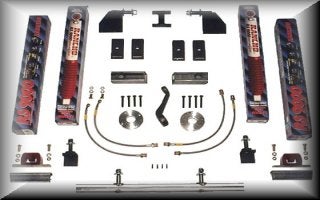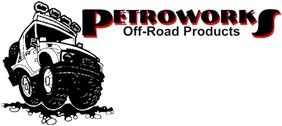- Low maintenance
- Strong construction
- Better on-road handling
- Better off-road handling and capabilities
- Ability to accommodate larger wheels and tires
- Desire for a wider track
- Better “ride”
- Overall opinions of various Suzuki owners as to best conversion type for Samurais for off-road use
- Resulting ride characteristics
- Wider track
- Welded construction for strength and low maintenance
- Improved on-road handling
- Articulation and off-road capabilities
- Use of OEM suspension mounting points for critical components as much as possible
Nothing like starting off a project in a major way. After spending over a year now reading the pros and cons of the various types of lifts on Off-road.com's Suzuki Pages and the Suzuk4x4 mailing list, I made the decision to lift my Samurai via a spring-over-axle conversion. This past month that conversion was made at Petroworks Off-Road Products' shop in Fallbrook, California.
 I worked right along side the people at Petroworks in performing this conversion, doing much of the disassembly
and reassembly work myself with their kind guidance. All welding was performed by Gary Munck, owner of Petroworks, as I'm no welder.
I worked right along side the people at Petroworks in performing this conversion, doing much of the disassembly
and reassembly work myself with their kind guidance. All welding was performed by Gary Munck, owner of Petroworks, as I'm no welder.
The conversion was slated to take approximately a day and a half of good solid work, although it proved to take a bit longer. Although this is by far the most complex auto project I have undertaken, I was never intimidated by any of the operations that had to be performed. I would call myself nothing more than your average “shade-tree” mechanic, and there was nothing that had to be done, save the welding, that I didn't feel capable of doing.
Kit contentsPetroworks' spring-over-axle kit comes in two versions, one with RS-9000 adjustable shocks, one without. Each kit contains:
| 4 | Con-ferr spring saddle pads (perches) | 2 | Rear bump-stops and mounting hardware |
| 2 | Front lower shock mounting brackets | 2 | Front stainless-steel-braided brake lines |
| 2 | Rear lower shock mounting brackets | 2 | Rear stainless-steel-braided brake lines |
| 1 | Rear shock upper mounting bar | 1 | Billet aluminum front propeller shaft extension |
| 1 | 3" dropped Pitman arm | 1 | Billet aluminum rear propeller shaft extension |
| 2 | Front bump-stop brackets | 1 | Drop bracket and hardware for the emergency brake cable |
| 2 | Rear bump-stop brackets | 8 | Propeller shaft extension mounting bolts |
If you order the kit with the RS-9000s (which I highly recommend!) you will also have:
| 2 | Rancho RS-9000 #9117 adjustable front shocks, mounting hardware and decals | 2 | Rancho RS-9000 #9118 adjustable rear shocks, mounting hardware and decals |
Way cool! Much to my dismay, I've not had a lot of time to do any serious wheeling since I got my conversion done. But I have gotten off-road, and I've had my usual running about on-road. Here's what I've noticed so far:
On-road handling
As far as I am concerned, on-road handling has definitely improved. Although there is no sway bar now, I've not noticed any increase in body sway in turns. I'm suspecting this is due to the wider track as well as the improved shock mounting points and shocks.
I have noticed a slight tendency for the vehicle to track pavement grooves that are parallel to the direction of travel, but that is most likely caused by the Goodyear MT's uni-directional tread design and large lugs. There's no noticeable bump-steer--a fact I attribute to the use of the drop Pitman arm and the modified drag-link.
The one negative I've noticed so far is that gearing is gonna have to be changed due to the big meats. That'll have to wait until I get a few more bucks in the modifications pile. I can live with it for now, but it's quite obvious that it will help on-road performance, as well as off-road.
Overall the truck feels more stable, and less skittish on the road. One thing I've definitely noticed is a much lessened tendency to “surf the bow-wave” of large trucks, and suddenly find oneself half a lane further left on the highway when passing. There is virtually no difference in tread noise over my old tires, which were M+S rated and not all that noisy. The truck is quieter on the highway due to the changed exhaust system as well. Finally, visibility is improved from the higher ride position.
Off-road handling
Night and day difference here! I retraced a portion of a trail I'd recently run while still stock, and the improvement was dramatic. First of all, I motored for quite a bit before I realized I had not yet remembered to shift into 4WD and lock the hubs. The only reason I did notice, was that I happened to feel that getting over a somewhat more difficult section was harder than it ought to be, and looked down to see if I had somehow slipped out of 4WD. What's memorable here though, is that I covered quite a few miles where 4WD would have been mandatory for me in stock configuration and had no trouble at all. I'm sure the new EZ locker in the rear was the primary reason for this change.
Off-camber sections of the trail are much less nerve-wracking than they were in the past. I've never much liked being too off-camber. Nose-down and nose-up don't bother me much at all, but off-camber angles simply don't feel right.
My education in the change in handling in this regard came when I got out to lock the hubs, at the point where I realized I wasn't yet in 4WD. I'm sure what happened was comical, so I'm glad there wasn't anyone around to see it when I got out, thinking that I was sitting nearly on the level, and found the ground was quite a distance below where I expected it to be. Where before the lack of axle articulation would have had me leaned over quite a bit, now the suspension was simply eating it up, leaving the body reasonably level. I found myself frantically grabbing the door to save myself from what would have been an embarrassing pratfall.
Next along the way was a pretty steep downhill with a number of “potholes” pretty much alternating between the left and right sides along the way. Into four low I went and crawled on down with no problem whatsoever. I doubt the stock setup would have made the trip at all.
I'm pleased with the much better off-road performance, and would have been willing to live with somewhat reduced on-road performance to achieve it, but I've not found that to be the case.
Ride differences
My girl-friend will attest to the fact that the overall highway ride is much improved. She was not pleased with the way the Sammy rode in the past. Now, the choppy feel that Samurais have is mostly gone. The ride is smoother and less prone to sudden jolts than it was. I've been running the RS-9000s at 3 on the highway for now (although I know Glenn would disagree). I suspect the improvement here is due to a combination of the shocks and the greater spring action of the larger tires.
Off-road I've been setting the shocks down to 1. (Yeah, Glenn, exactly opposite of what you do). The extra-soft valving in that setting really makes the Sammy kind of ooze over the obstacles. I'm told that it would help to air down as well. Until I get some way to air back up, however, I'm gonna have to take people's word for the benefits of airing down.
What I would have done differently- Gotten the chassis steam-cleaned prior to doing the conversion. It simply would have made things simpler (not to mention less messy) by saving a number of individual cleaning operations that had to be performed along the way.
- Added the in-cab control unit for the RS9000s. The position of the rear shocks makes it difficult to reset them without having to crawl under the vehicle. Adding the in-cab control later will be a little harder than it would have been had it been installed during the conversion.



 Your Privacy Choices
Your Privacy Choices